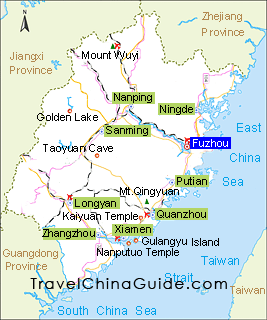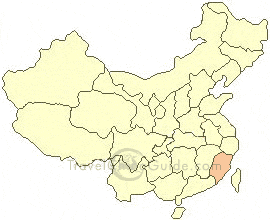
| Introduction |
Capital of Fujian provice, Fuzhou is a 2,000-year-old city with rich cultural heritage. It lies opposite Taiwan across the strait. The city abounds in banyan trees that were mostly planted at the time of the Northern Song Dynasty (A.D. 960-1127). So Fuzhou is also known as Rong Cheng, meaning the City of Banyans. Fuzhou has been the native place of famous men over the generations who made history. More historical sites are found in the city of Fuzhou than most of other Chinese cities. The three hills of Yu, Wu and Ping stand at triangular positions, while the two pagodas Bai Ta(White Pagoda) and Wu Ta (Black pagoda) face each other at a distance. These make up the city’s landscape. Places of interest include the residence stone carvings and the cork sculpture, are objects of admiration since early on both in China and abroad. Fuzhou has abundant hot springs, and good quality hot spring water is supplied at the bathrooms of hotels. Fuzhou is also famous for culinary art. Gourmets’ fascinations are such delicacies as Fo Tiao Qiang (Buddha-Jumps- Over-The-Wall) and clams in chicken soup. Fuzhou is accessible by modern routes of communication. It welcomes tourists from abroad and elsewhere in China. |
![]() By Air
By Air
Fuzhou Changle International Airport (FOC) is situated in a sandy area of southeast Zhanggang Town, Changle City, some 55 kilometers (about 34 miles) from downtown Fuzhou, and is a modern, seashore based international airport. There are now approximately 75 airlines operating out of FOC, including 65 domestic services, 2 regional airlines and 8 international services at this airport. Domestic services include flights from Beijing, Shanghai, Guangzhou, Shenzhen, Jinan, Shenyang, Harbin, Chongqing, Chengdu, Zhengzhou, Kunming, Haikou, Urumqi and Xian, etc. International services include flights from Singapore, Bangkok, Kuala Lumpur and Osaka to Fuzhou City. There are also daily scheduled flights from Hong Kong and Macau.
Tourists are advised to take the safe and comfortable airport bus which will take between one to one and a half hours to downtown Fuzhou and will cost about 25 Yuan per person to the Apollo Hotel, located on Wuyi Lu, Fuzhou City. If you want to take a taxi, the cost can be negotiated, but will be between 100 and 120 Yuan. Returning to the airport from downtown Fuzhou, tourists can take the airport bus from the Apollo Hotel, or make a reservation for a taxi stopping at Apollo Hotel the day prior to departure and negotiate a price, which will far be far more reasonable than for you to stop a taxi on the road the day of your flight.
Fuzhou Changle International Airport Enquiry: (0591) 28013246
![]() By Train
By Train
Fuzhou Railway Station is the transportation hub of Fujian Province. It is located at the north end of Hualin Lu, in the northern part of the Fuzhou downtown area. Fuzhou station is connected with the national railway network and operates services to Beijing, Shanghai, Qingdao, Zhengzhou, Nanjing, Nanchang, Guiyang, Changsha, Hefei, Chengdu, Chongqing, and Shenzhen. Also there are tourist lines from Nanping, Longyan, Yong’an and Wuyi Shan to Fuzhou.
Fuzhou Railway Station Ticket Office: 0591-87577849
From Fuzhou Railway Station, tourists may take bus Nos. 5, 17, 20, 26, 51, 821, 905, 917, 949 and 951, also Yaxiya Zhuanxian (Asia Special Line), Xi Er’ huan Zhuanxian (Western 2nd Ring Road Special Line) to Fuzhou downtown for the ticket of 1 yuan.
Train tickets can be bought in the ticket office usually seven days prior to the departure date. During some traditional festivals like Spring Festival, tourists can buy the ticket eight days or more in advance. The main ticket offices in the downtown area are as follow.
Wuyi Ticket Office: 142, Wuyi Lu (opposite the Drum Tower Hospital)
Hualin Ticket Office: 203, Hualin Lu
Tangcheng Da Sha Ticket Office: 215, Wuyi Nan Lu (1/F, Tangcheng Dasha)
![]() By Bus
By Bus
South Long-Distance Bus Station opened inter-province highways between Fuzhou and Weihai, Weifang, Ningbo, Guilin, Hangzhou, Wenzhou, Haikou, Guangzhou, Shenzhen, Dongguan, Hong Kong and Shantou run every day. And the lines between Fuzhou and Beijing, Shanghai, Qingdao, Yantai run once every two days.
Address: 190, Wuyi Zhong Lu
North Long-Distance Bus Station is situated at No. 371, Hualin Lu, Gu Lou Qu
Hongshan Passenger Transport West Station
Address: Hongshan Chenguang Cun
![]() By Ship
By Ship
Located in the lower reaches of the Min River, Fuzhou is an old estuary harbor. The Min Rive sea route of Fuzhou is from Nanping to Mawei, the passenger liners of Mawei harbor can bring you to Mt. Putuo, Ningbo etc. Out of the east estuary of the Min River, tourists can get passage to the main ports of the Yangtze River, north to Shanghai and Qinhuangdao, south to Xiamen and Hong Kong and east to Keelung in Taiwan. There are buses and tourist line in Mawei harbor that will take tourists to downtown Fuzhou and some of the sights in Fuzhou City.
Fuzhou Travel Guide
 Located in the lower reaches of the Min River, the capital city of Fujian Province, Fuzhou City is situated in the eastern part of the Province. Fuzhou, the center of economic, political, cultural and transportation of Fujian Province, was so named after a mountain situated in the north called Mt. Fu. Additionally, many banyans were planted in the Song Dynasty (960-1279), and now provide shade for the entire city giving it another good name - Rong Cheng (Banyan City). Besides, the city is renowned for both quality and quantity of hot springs throughout China. The cultured sights of Fuzhou are not as overwhelming as many of the top attractions in China, but the modern infrastructures of supporting establishments for tourism are complete, and a dazzling array of local dishes and snacks await your patronage.
Located in the lower reaches of the Min River, the capital city of Fujian Province, Fuzhou City is situated in the eastern part of the Province. Fuzhou, the center of economic, political, cultural and transportation of Fujian Province, was so named after a mountain situated in the north called Mt. Fu. Additionally, many banyans were planted in the Song Dynasty (960-1279), and now provide shade for the entire city giving it another good name - Rong Cheng (Banyan City). Besides, the city is renowned for both quality and quantity of hot springs throughout China. The cultured sights of Fuzhou are not as overwhelming as many of the top attractions in China, but the modern infrastructures of supporting establishments for tourism are complete, and a dazzling array of local dishes and snacks await your patronage.
Fuzhou is both a historic and a cultural city with an over two-thousand-year of history and in 908, Fuzhou was expanded. This expansion included Mt. Yu, Mt. Wu and Mt. Ping within its jurisdiction. The city is also prosperous in culture, from the Tang (618-907) through to the Qing Dynasty (1644-1911); there were thousands of Jinshi (a successful candidate in the highest imperial examinations) from Fuzhou. Many celebrated figures from Chinese history also hailed from this land, and thus, the birth of heroes also brings glory to such a place. Because of its long and flourishing history, there are many arts related industries represented, including the Three Treasures of Fuzhou (lacquer work, stone sculpting and cork cutting), a featured dining culture, and also traditional arts including Min Opera, etc. which still take an important role in today’s Chinese culture.
The climate of Fuzhou is comfortable, affording tourists the opportunity to visit the city all the year round, especially between April and November. Fuzhou is a tourist city that boasts both natural and manmade sights. Famous mountains include Mt.Gu, Qi, Shizhu, Baiyan and Xuefeng etc. Famous temples include Yongquan, Xichan, Linyang, Fahai and Yunju etc. Famous tombs like Tomb of Lin Zexu etc. Famous gardens include West Lake etc. Famous towers include the White, Wu and Luoxing etc. and famous bridges including Wanshou and Longjiang etc. and also many former residences of celebrated historical figures. You may find that there are far too many things to see here in one short trip.
Here we have a simple introduction of orientation for guiding tourists’ first trip through downtown Fuzhou. In terms of geography, the center of Fuzou City is Wuyi Square and Dongjiekou is the commercial center of downtown Fuzhou. From railway station bus No. 20 will take tourists to Dongjiekou, Bus No. 51 will bring tourists to the crossing of Wusi Lu and Hudong Lu - the financial center of Fuzhou, and bus No. 821 will take tourists to Jinshan, the new expanded city area.
The tourism industry of Fuzhou with its sustainable, fast and healthy development is being perfected day by day. In this coastal city, the reception establishments related to tourism are modern. At present, there are over 80 stared hotels, and the recreational facilities are too numerous to mention. The transportation network of Fuzhou is well developed and incorporates the road, rail, water and aviation networks, providing your trip to Fuzhou with convenient all-around access.
Fuzhou will continue to develop its prosperous, modern and well rounded tourism industry. With its ancient culture and exquisite sights, the city welcomes the global tourist and we hope Fu (meaning good fortune in Chinese) zhou will both bless you and bring you back.
Fujian has a year-round warm and humid climate. Annual average rainfall ranges from a low of 1400 mm to a high of 2000 mm, and annual average temperature from a low of 17
Fujian is blessed with a rich history, famous historical sites and beautiful natural landscapes. These make Fujian a unique tourist attraction. However, it is not yet a much worn traveler’s path. Mount Wuyi (Wu Yi Shan) may enlighten you with its wonderland tour. Its beautiful mountains, vigorous rocks and limpid waters are legendary.Gulangyu Island, also called "the Garden on the Sea" by people in Xiamen, is a world of sea breezes, sunshine and exotic architecture with a Mediterranean flavor. Nanputuo Temple, among the four well-known Buddhist shrines in the nation, has the longest and most prestigious history. Earth Towers of the Hakkas in Yongding area are the much fabled mountain residences in this world of make believe. The industrious and facile Hui’an women in the south of Fujian add much to their folk customs. The Kaiyuan Temple looks splendid, glittering and grand despite its age. Fujian also is a place where famous national heroes like Lin Zexu and Zheng Chenggong lived and won their seats of honor in history books. Oolong tea produced in Fujian is famous, so if you have a chance to visit this province, you must taste it there with relish. |
Tel:86-754-88841111,88846222 Fax:86-754-88846000, 88846777
中国免费电话.Toll Free:800-999-2333 Copyright2007,All Right Reserved



 Fujian
Fujian